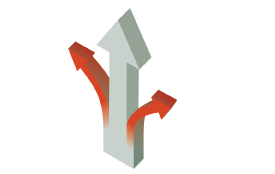 One concern is that low-income drivers would be unable to afford congestion-priced lanes. However, CMAP's modeling analysis indicates that drivers from all income groups would use congestion-priced facilities. The median income of express lane users would be 13 to 19 percent higher than users of the general purpose lanes -- somewhat higher, but not dramatically so.
One concern is that low-income drivers would be unable to afford congestion-priced lanes. However, CMAP's modeling analysis indicates that drivers from all income groups would use congestion-priced facilities. The median income of express lane users would be 13 to 19 percent higher than users of the general purpose lanes -- somewhat higher, but not dramatically so.
Surveys in other regions show similar results. For example, surveys about I-394 in Minnesota found that 55 percent of low-income respondents used the express toll lanes at least once, as did 70 percent of middle-income respondents and 79 percent of upper-income respondents. In total, 64 percent of lower-income respondents approved of the I-394 express lanes. On Southern California's SR 91, about one-fifth of rush-hour drivers make less than $40,000 a year, and over half of commuters with incomes less than $25,000 approved of the toll lanes.
Policies should be adopted to address equity concerns. For example, transit vehicles could use express lanes for free, and surplus revenues from congestion pricing could be used to fund transit service. In another approach, drivers in the region could be given a base number of "lifeline" travel credits for free travel, then they would only pay for travel above that level. Another possible alternative is that lower-income drivers could be charged a discounted toll rate or be allowed to deduct tolls from congestion pricing on their state income taxes.
 Another concern about congestion pricing is that the regular lanes will become more congested as they absorb the drivers who are not willing to pay the premium. Some drivers would use local roads instead of the expressway, shifting congestion onto those streets. CMAP's modeling analysis indicates that implementing congestion pricing on new capacity would lessen delays on local roads by 6 to 10 percent. Still, this issue requires more study on specific highways. Locations of access points should be chosen to minimize spillover, and if needed, surface streets could be improved to handle increased traffic.
Another concern about congestion pricing is that the regular lanes will become more congested as they absorb the drivers who are not willing to pay the premium. Some drivers would use local roads instead of the expressway, shifting congestion onto those streets. CMAP's modeling analysis indicates that implementing congestion pricing on new capacity would lessen delays on local roads by 6 to 10 percent. Still, this issue requires more study on specific highways. Locations of access points should be chosen to minimize spillover, and if needed, surface streets could be improved to handle increased traffic. Accommodating congestion pricing can be a significant engineering challenge, particularly for existing highways. Available right-of-way, safety, traffic operations, enforcement, technology, and environmental concerns all need to be considered. However, CMAP expects that congestion pricing will be feasible on many roads in the Chicago region, as it has been found feasible elsewhere.
Accommodating congestion pricing can be a significant engineering challenge, particularly for existing highways. Available right-of-way, safety, traffic operations, enforcement, technology, and environmental concerns all need to be considered. However, CMAP expects that congestion pricing will be feasible on many roads in the Chicago region, as it has been found feasible elsewhere.